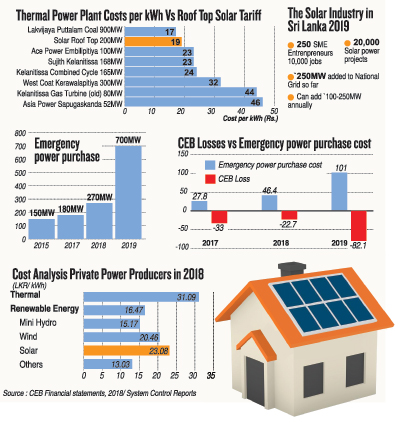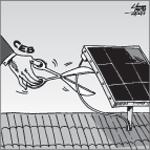News
Up on the roof, solar concerns grow over tariff changes
 A plan to force households to sell the solar energy they produce to the government instead of being able to use it themselves has angered thousands of green energy consumers and experts say the scheme threatens the booming rooftop solar industry.
A plan to force households to sell the solar energy they produce to the government instead of being able to use it themselves has angered thousands of green energy consumers and experts say the scheme threatens the booming rooftop solar industry.
Under the proposed tariff, the board (CEB) wants to keep the monopoly option of the Net Plus scheme – where solar powered-households are paid to contribute to the national grid rather than turn the excess power they generate to their own use – and ditch two other schemes currently in operation.
In 2016, the government launched “Battle of Solar Power”, an ambitious plan aimed at generating 1,000 megawatts (MW) by one million solar rooftops by 2020.
Households could sell electricity to the national grid at the following prices: for the first seven years, the price would be Rs 22 per kilowatt hour (kWh); from years eight to 20 the price would be Rs. 15.50 per kWh. Consumers were given the choice of three solar schemes: Net Metering, Net Accounting and Net Plus.
Under Net Accounting and Net Plus, the CEB offered to pay consumers for either surplus or total energy generation. Under Net Metering, there would be no payment from the CEB: customers could use the surplus power they generated.
High-end consumers of electricity in urban areas opted for the Net Metering scheme as it allowed high usage at a cheap price. Middle-class and lower-income families preferred the other two modes which generated a reasonable monthly income.
Now, the CEB has decided to only retain Net Plus and scrap the other two options.
Under the new electricity tariff plan proposed by the Ministry of Power, Energy and Business Development, only Net Plus would operate: the other two schemes would be scrapped.
If this new scheme becomes effective, users only have the option of selling the solar power they generate to CEB but not being able to direct it towards domestic usage.
A new price structure would be employed: over a 20-year period, a unit less than 50 KW would receive Rs. 19.75 in payment from the CEB; a unit of 50-1,000 KW would get Rs. 18.75, and a unit more than 1,000 KW could get Rs.16.
Currently, the cost of purchasing solar power under the Net Metering scheme is Rs. 45 per unit while under the other two methods, it is fixed at Rs. 22 per unit.
The proposed tariff charges, according to the Ministry of Power, Energy and Business Development, will apply from August 1.
Minister of Economic Reforms and Public Distribution Dr. Harsha de Silva, a member of the committee, told the Sunday Times that given the rising cost of living, middle-class household owners should be given the chance to consume the solar energy they generate on their rooftop instead of being forced by the CEB to buy power from the national grid.
The CEB denies that any final decision has been taken on the new tariffs plan.
“That was not a final decision taken by the ministry as claimed by many but merely a proposal to review the current prices,” a spokesperson for Ministry of Power, Energy and Enterprise Development, Sulakshana Jayawardena, said.
“There is a need to formulate revised prices considering the technical and financial aspects of this industry since we already reached the milestone of contributing 200MW to the national grid by 2020,” Mr. Jayawardena told this paper.
 Denying allegations that the revised tariffs are aimed at discouraging people to use solar energy, Mr. Jayawardena stressed the government had no intention of abolishing the solar programme.
Denying allegations that the revised tariffs are aimed at discouraging people to use solar energy, Mr. Jayawardena stressed the government had no intention of abolishing the solar programme.
When asked why the CEB was paying higher costs for fossil fuel-sourced energy compared to solar energy, he said the CEB could not depend solely on the sustainability of the solar energy.
As well, he said, there were certain limitations in granting approvals to set up rooftop solar panels.
One such arbitrary limitation came to light early this month when the CEB Deputy General Manager in Western Province North, M.T.P.D. Thanthirimalage, issued an internal circular to his subordinate officer not to grant any more approvals for rooftop solar connections over 50kW capacity in the region.
Mr. Thanthirimalage confirmed to this paper that the circular had been issued but said it had since been withdrawn and there were no shortcomings in granting new approvals.
Solar Industries Association (SIA), a collective of solar energy companies and service providers of solar panels, expressed severe concerns over the new tariff proposal, saying it would make large-scale solar projects commercially unviable.
SIA Secretary Lakmal Fernando said this “secret move” by the ministry and the CEB, without securing cabinet approval or holding prior discussions with stakeholders, posed a bleak future for an industry that has created thousands of job opportunities and entrepreneurs in recent years.
“In the solar industry, over 10,000 people are currently employed by about 250 small and medium-scale companies which, together, have installed 19,700 solar projects around the country.
“In addition, solar power added 250MWp (MegaWatt peak) of power to the national grid, which is a significant contribution,” said Mr. Fernando, who is also a director of a leading renewable energy company based in Colombo.
Power generated from solar roof panels increased the capacity of the national grid by 1.6 per cent to 4,063MW in 2018, according to the report, “Performance 2018 and Programmes for 2019”, issued by the Ministry of Power, Energy and Enterprise Development.
By 2018, almost 5,500 households (totalling some 12,680 consumers) were contributing to the national grid through solar panels on their roofs.
With demand for electricity growing at a rate of about 5-6 per cent a year and no likelihood of major power plants being built before 2020, the government is left with no other options other than to buy emergency power to meet power crises.
This comes at a higher cost: while the cost of adding solar power to the national grid is currently Rs 19.75 per kWh, emergency power costs Rs. 30 per kWh.
On Friday, Sanjeeva Dhammika, a consumer rights activist lodged a complaint at the Human Rights Commission office in Colombo alleging that elements at the Ministry of Power and Energy are behind the government’s recent move to purchase emergency power from a Turkish company at a high cost.
He says the increasing demand for power could have been easily met with proper planning and investment in renewable energy.
“Compared to prices the government has to pay for fossil fuel-sourced power to address the power crisis, prices for renewable energy sources are relatively low. Despite this, the ministry went ahead with this plan, paying out billions of rupees of taxpayers’ money,” Mr. Dhammika said.
This year alone, emergency power purchases of 700MW cost more than Rs. 100 billion, Power, Energy and Business Development Minister Ravi Karunanayake admitted in parliament this week.
He said no final decision had been taken on the planned new tariff charges as the ministry was reviewing the entire solar power energy programme.
| ADB-funded green energy scheme could be at risk | |
| The planned tariff changes for solar power have also placed in doubt a programme initiated last year, funded by a $US50 million Asian Development Bank (ADB) loan, to encourage the public to invest in green energy. This Rooftop Solar Power Generation project allowed people to obtain commercial loans at a low interest rate of 8 per cent a year to install solar power panels at their homes for domestic consumption. As well as being threatened by the prospect of the tariff changes, the programme also is bedevilled by administrative complexities. Potential users claim that securing this loan is a huge task and a complicated process. When Jegatheeswaran Arujeenan, an IT enthusiast now engaged in farming near Kopay in Jaffna approached state banks for a loan under the ADB-financed scheme, he found only a few banks were aware of it. Today, after months spent on preparing documents and meeting administrative requirements to get the loan, he is yet to wait for a green light from the relevant bank. “The whole process turned out to be very complicated, from getting formal approval from the nearby CEB branch to securing a bank loan from a state bank, particularly in proving personal repayment capacity where the property is to be mortgaged as security,” Mr. Arujeenan said. He also fears he might need to reconsider his plans to install solar rooftop panels if the CEB implements the proposed tariff charges because the installation would no longer be financially viable. |

